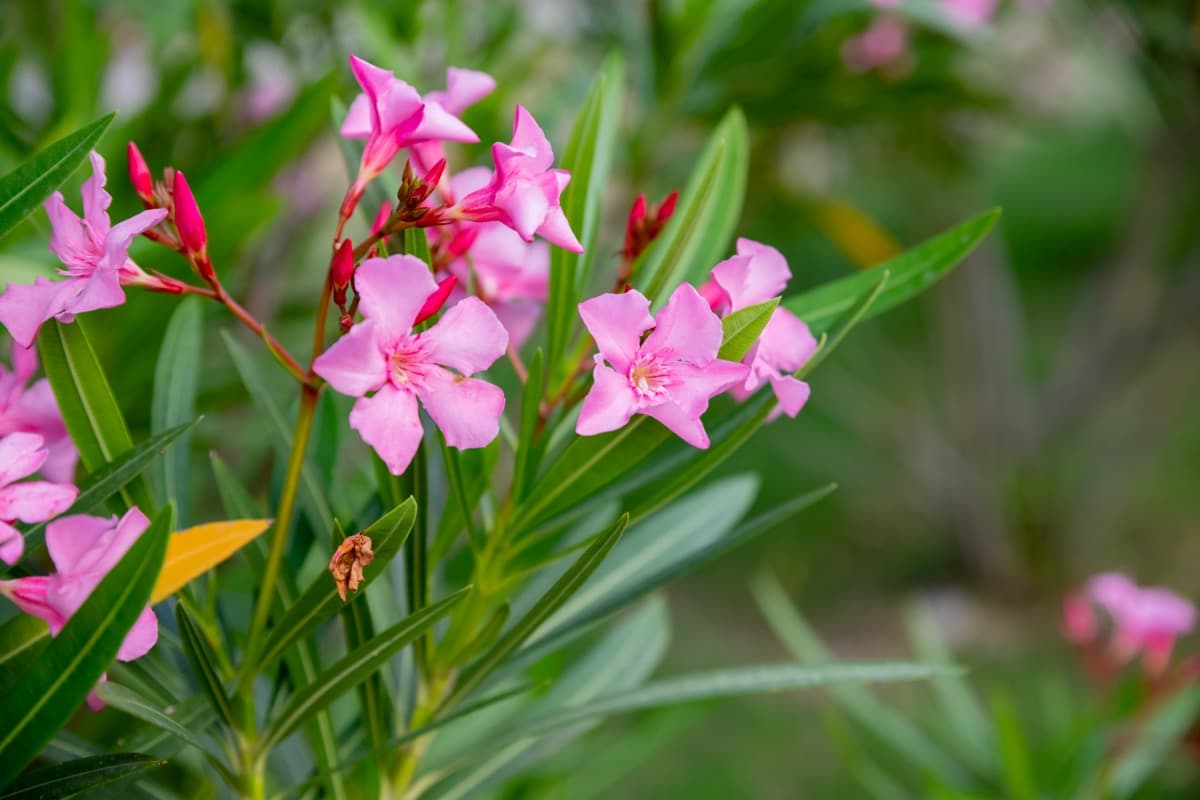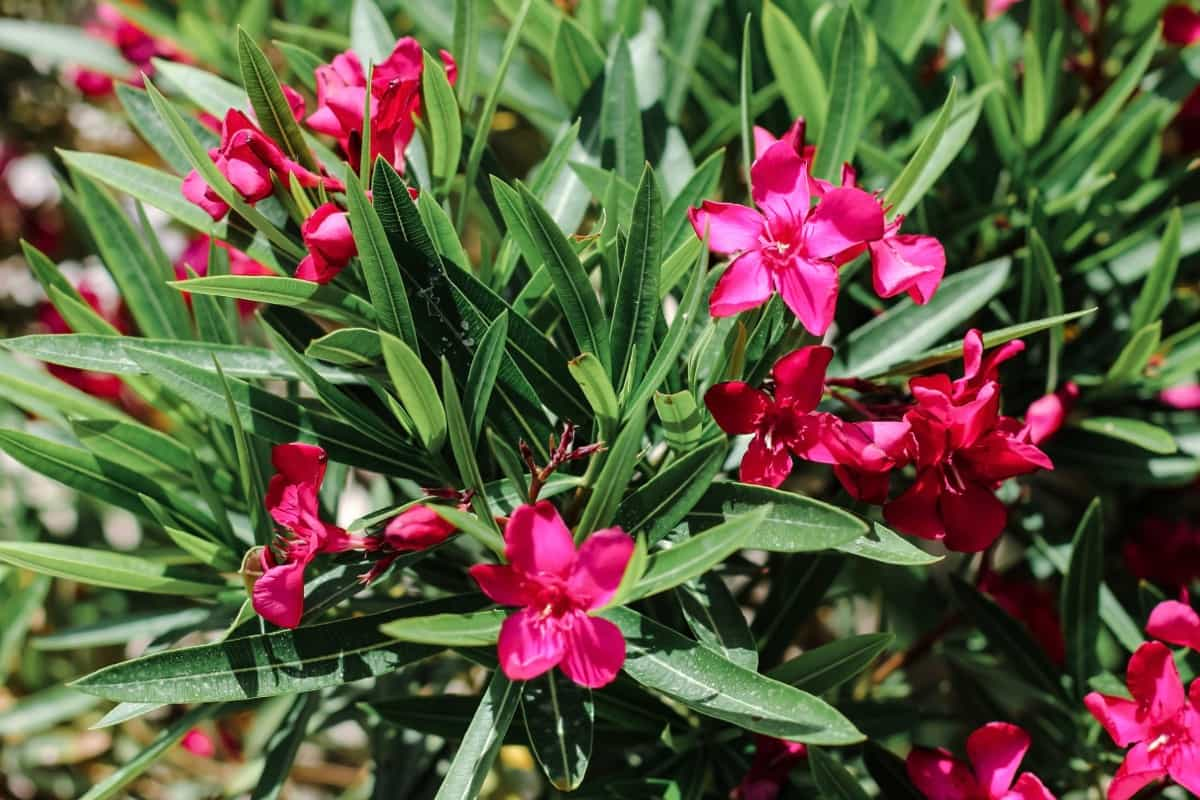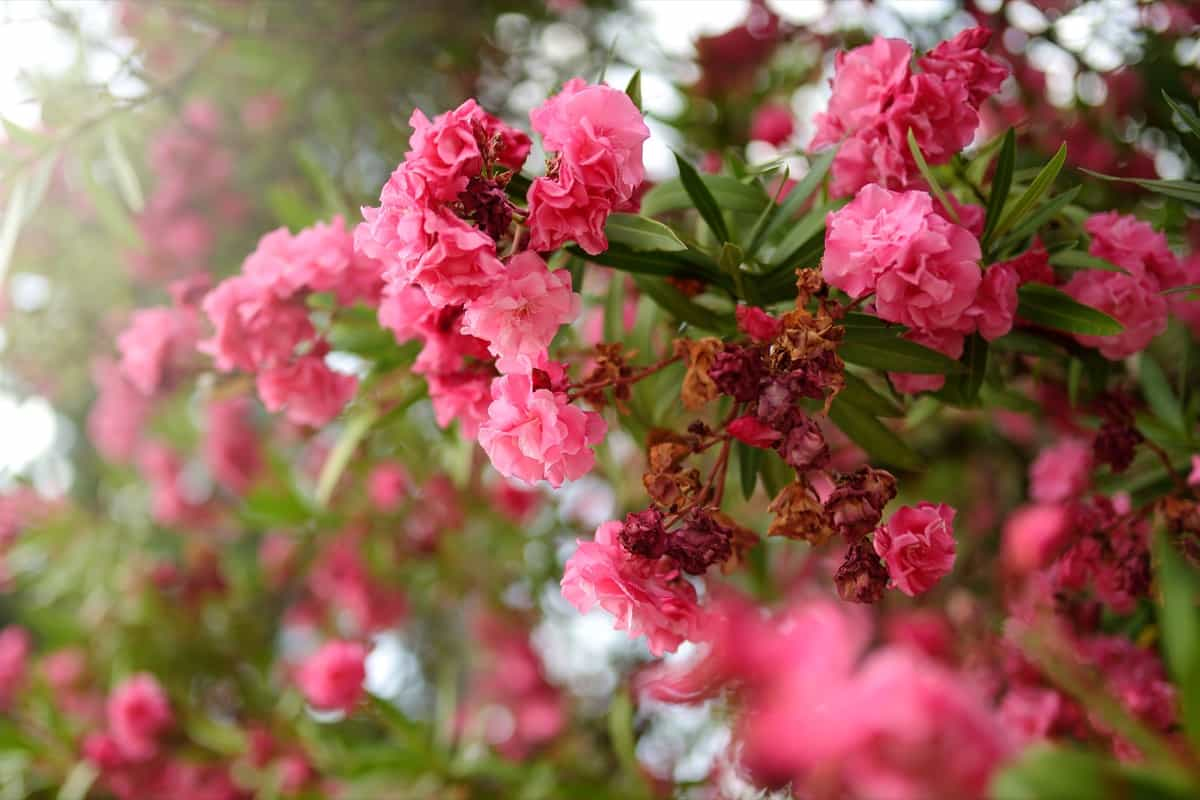Welcome to our blog on Common Nerium plant diseases and control! This article will explore the causal organisms, damage symptoms, spread, treatment options, prevention strategies, and management techniques for these diseases. Connect with us to discover ways to safeguard your Nerium plants and guarantee a nice crop. So, let’s get started.

Major and Common Damaging Nerium Diseases
Nerium, also known as oleander, is a perennial evergreen or semi-evergreen flowering shrub in the Apocynaceae family, native to the eastern Mediterranean, North Africa, and Arabian Peninsula, reaching 2 to 6 meters in height.
The leaves are long, narrow, and arranged in whorls along the stem, giving the plant an attractive, symmetric appearance. Its flowers are eye-catching and occur in white, pink, and red shades, often with intricate patterns and delicate fragrances. It is important to note that nerium plants contain toxic compounds and should be cautiously handled.
| Disease | Characteristic Symptoms |
| Bacterial blight | Water-soaked lesions, yellow halo, defoliation, & dieback of branches. |
| Canker | Sunken, necrotic lesions, sap oozing, & dieback of affected branches. |
| Botrytis Blight | Brown or gray fuzzy mold, the collapse of plant tissues, & flower rot. |
| Anthracnose | Water-soaked lesions with concentric rings & premature leaf drop. |
| Powdery Mildew | White or gray powdery patches, premature leaf drop, & reduced flowering. |
| Fusarium Wilt | Yellowing and wilting of leaves & vascular discoloration. |
| Southern Blight | White, fluffy fungal mycelium, sclerotia, & stem and crown rot. |
| Leaf Spot | Brown spots, premature leaf wilting, water-soaked appearance. |
| Mosaic | Mottled or mosaic patterns, chlorosis, & flower deformities. |
| Root Rot | Yellowing and wilting of leaves, root discoloration, & foul odor. |
How to Identify and Treat Nerium Diseases
Bacterial Blight Disease Control In Nerium
- Causal Organism: Xanthomonas campestris pv. nerii
- Symptoms: The most noticeable symptom is the water-soaked lesions on leaves, stems, or flowers, often with a yellow halo. Lesions may enlarge, turn brown, and become necrotic. Infected plants show extensive defoliation, dieback of branches, and reduced plant vigor. In severe cases, leaf wilting and browning are noticed.
- Spread: The bacteria spread via contaminated tools, insect vectors, splashing water, and wounds or natural openings.
- Treatment: Spray copper hydroxide or copper sulfate. Prune and destroy infected plant parts. Avoid water splashes and water at the base. Disinfect tools between uses to prevent spread.
Canker Disease Control in Nerium
- Causal Organism: Diaporthe spp. and Phomopsis spp.
- Symptoms: The characteristic symptom is the formation of sunken, necrotic lesions on stems or branches. Lesions may be discolored, cracked, or ooze sap. Infected plants show a water-soaked appearance, dieback of affected branches, and reduced plant vitality.
- Spread: The pathogen spreads via contaminated tools, wounds, natural openings, or infected material.
- Treatment: Spray metalaxyl, mefenoxam, or phosphorous acid. Prune and remove infected branches, clean pruning tools between cuts and avoid wounding to prevent spread.
Botrytis Blight Disease Control in Nerium
- Causal Organism: Botrytis cinerea
- Symptoms: The primary symptom is brown or gray fuzzy mold on flowers, buds, or affected plant parts. Infected plants show browning, wilting, or collapse of plant tissues, and infected flowers may turn brown, rot or decay, or fail to open.
- Spread: The spores are spread via air, rain splashes, infected plant debris, contaminated tools, or physical contact with infected plants.
- Treatment: Spray thiophanate-methyl, iprodione, or boscalid. Ensure spacing for air circulation, avoid overwatering to keep foliage dry, rogue out and destroy infected plants, and practice sanitation.
In case you missed it: How to Identify and Treat Nerium Pests: Damage Symptoms, Prevention, and Control

Anthracnose Disease Control in Nerium
- Causal Organism: Colletotrichum spp. and Glomerella spp.
- Symptoms: The primary symptom is the expansion of small, sunken, or water-soaked lesions on leaves, stems, or flowers and forming dark centers with concentric rings. Infested plants show premature leaf drop and defoliation.
- Spread: Spores disperse via rain splashes, wind, insect vectors, wounded plant tissues, or natural openings.
- Treatment: Apply azoxystrobin, thiophanate-methyl, or mancozeb. Provide adequate spacing for good air circulation. Monitor the plants regularly, and avoid overhead irrigation and water at the base.
Powdery Mildew Disease Control in Nerium
- Causal Organism: Erysiphe spp. and Oidium spp.
- Symptoms: The characteristic symptom is white or gray powdery patches on leaves, stems, and flowers. Infected plants show leaf chlorosis, premature leaf drop, distorted or stunted growth, and reduced flowering.
- Spread: Fungal spores are spread via wind, overhead irrigation, or excess humidity.
- Treatment and Management: Spray wettable sulfur, neem oil, or potassium bicarbonate. Practice pruning, sanitation, and spacing. Ensure good air circulation and water plants at the base.
Fusarium Wilt Disease Control in Nerium
- Causal Organism: Fusarium oxysporum
- Symptoms: The primary symptom is the yellowing and wilting of leaves, usually starting from the lower branches. Infected plants show browning or darkening of the vascular tissues, stunted growth, and plant death in severe cases.
- Spread: The fungi are soil-borne and spread via contaminated soil, infected plant debris or tools, and wounds or natural openings.
- Treatment and Management: Spray propiconazole, tebuconazole, thiophanate-methyl, or benomyl. Practice crop rotation and rogue out infected plants. Maintain plant health and vigor.
Southern Blight Disease Control in Nerium
- Causal Organism: Sclerotium rolfsii
- Symptoms: The characteristic symptom is the formation of a white, fluffy fungal mycelium on the stem, soil, and around the base, accompanied by tan to dark brown fungal structures called sclerotia. Infected plants show leaf chlorosis, wilting, stem rot, crown rot, and water-soaked appearance.
- Spread: Fungal spores are soil-borne and spread via splashing water, infected plant debris, physical contact, and human activities.
- Treatment and Management: Spray thiophanate-methyl, flutolanil, or iprodione. Practice crop rotation, sanitation, soil solarization, and spacing. Avoid overwatering and ensure proper drainage.
Leaf Spot Disease Control in Nerium
- Causal Organism: Xanthomonas campestris pv. nerii, Phyllosticta spp., Colletotrichum spp., Phoma spp., and Cercospora spp.
- Symptoms: The characteristic symptom is the development of circular to irregular spots on leaves, often with a tan or brown center and dark borders. Infested leaves show premature leaf wilting, water-soaked appearance, chlorosis, extensive defoliation, reduced plant vigor, and necrosis.
- Spread: Fungal spores are spread via splashing water, wind, or insect vectors.
- Treatment and Management: Spray copper hydroxide, copper sulfate, azoxystrobin, mancozeb, or chlorothalonil. Practice sanitation, roguing, and spacing. Enhance ventilation, and avoid overhead watering to minimize leaf wetness.
Mosaic Disease Control in Nerium
- Causal Organism: Nerium Mosaic Virus
- Symptoms: The primary symptom is the formation of mottled or mosaic patterns on leaves. Infected plants show leaf yellowing, stunting, distorted growth, reduced plant vigor, poor flowering, flower deformities or color changes, and an overall decline in health.
- Spread: Viruses are primarily spread via vectors such as aphids, thrips, or other sap-sucking insects from infected plants.
- Treatment and Management: Spray insecticidal soaps like potassium salts for aphid and thrips control. Prune and destroy infected plants. Control insect vectors via barriers, insecticides, or physical exclusion methods. Plant disease-free stock from reliable sources.
In case you missed it: How to Identify and Treat Anthurium Diseases: Symptoms, Control, Treatment, and Prevention

Root Rot Disease Control in Nerium
- Causal Organism: Rhizoctonia spp., Pythium spp., and Phytophthora spp.
- Symptoms: The most noticeable symptom is the wilting and yellowing of leaves, even with adequate moisture. Infected plants show leaf chlorosis, stunted growth, and reduced vigor. In severe cases, roots may show brown or black discoloration with a foul odor.
- Spread: Pathogens are soil-borne and spread via wounded roots or natural openings, infected plant debris or tools, and contaminated soil.
- Treatment and Management: Spray captan, metalaxyl, mefenoxam, or phosphorous acid. Prefer well-draining soil and avoid waterlogged conditions. Ensure proper drainage to avoid waterlogging. Avoid injury to roots during planting or cultivation.
Conclusion
Some major diseases affecting nerium plants include bacterial blight, canker, botrytis blight, anthracnose, powdery mildew, fusarium wilt, southern blight, leaf spot, mosaic, and root rot disease. Various organisms cause these diseases and exhibit specific symptoms, modes of spread, and management approaches.
- Deworming Schedule for Dogs/Puppies: A Beginners Guide
- How to Prevent and Control Parasites in Goats
- Beneficial Insects in Pest Management
- Natural Solutions for Pest Control in Flower Gardens
- Types of Fungicides Used in Agriculture
- Common Issues in the Fruit Development Stage of Pomegranate Farming
- Fruit Development Issues in Papaya: Easy Solutions and Treatment
- Soil-Borne Diseases and How to Protect Your Plants
- Practices to Prevent Disease Spread in the Garden